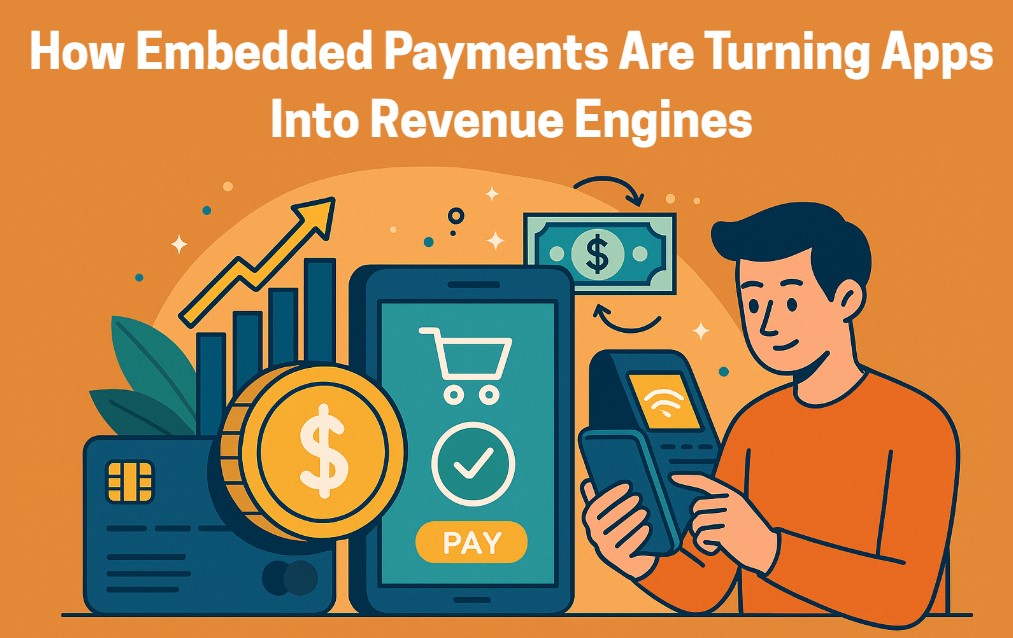Digital Marketing
How Embedded Payments Are Turning Apps Into Revenue Engines

Apps are no longer just tools—they’re becoming financial powerhouses. By integrating embedded payments directly into their platforms, marketplaces, SaaS companies, and creator platforms are unlocking new revenue streams worth billions. This isn’t just about processing transactions; it’s about capturing value at every touchpoint of the user journey.
In this article, we’ll explore how embedded payments transform apps into revenue engines, what product teams need to build to capture this value, and the concrete API flows that make it all possible. Whether you’re running a marketplace, SaaS platform, or creator economy app, embedded payments could be your next major growth lever.
The Embedded Payments Revolution
Remember when Uber was just a ride-hailing app? Today, it processes over $100 billion in payments annually, taking a cut from every transaction. This transformation didn’t happen by accident—it happened because Uber embedded payments seamlessly into their user experience.
Embedded payments are financial services integrated directly into non-financial applications. Instead of redirecting users to external payment processors, the entire transaction happens within your app’s ecosystem. This creates a smoother user experience and, more importantly, new opportunities to capture revenue.
Why Now?
Three key factors are driving the embedded payments boom:
- User expectations: Customers demand frictionless experiences
- API infrastructure: Modern payment APIs make integration easier than ever
- Revenue pressure: Apps need new monetization models beyond subscriptions and ads
How Apps Monetize Through Embedded Payments
1. Transaction Fees and Commissions
The most obvious revenue stream is taking a percentage of every transaction. But smart apps are getting creative:
Marketplaces like Etsy take 6.5% transaction fees plus payment processing fees. By embedding payments, they control the entire flow and can optimize for higher conversion rates.
Creator Platforms like Patreon charge creators 5-12% of earnings. Their embedded payment system handles subscriptions, one-time tips, and merchandise sales—all while taking their cut.
2. Float Revenue
When you hold customer funds (even briefly), you can earn interest on that money. This “float revenue” adds up quickly:
- Gig Economy Apps: Hold payments for 24-48 hours before paying drivers/workers
- Marketplaces: Keep seller payouts for 3-7 days for “security”
- SaaS Platforms: Collect annual subscriptions but pay vendors monthly
3. Premium Payment Features
Basic payments might be free, but premium features generate recurring revenue:
- Instant payouts: Charge $0.50 for same-day transfers instead of standard 3-5 days
- Multi-currency support: Add 2-3% for international transactions
- Advanced analytics: Subscription fees for detailed payment insights
4. Cross-Selling Financial Services
Once you handle payments, you can offer complementary financial products:
- Lending: Offer cash advances based on payment history
- Banking: Provide business accounts and debit cards
- Insurance: Sell coverage for transactions or inventory
What Product Teams Must Build
Core Infrastructure Requirements
Building embedded payments isn’t just about adding a payment button. Product teams need to architect several key components:
1. Multi-Party Payment Flows
Unlike simple e-commerce, platform payments involve multiple parties:
Customer Payment flows to Platform Fee deduction then to Merchant Payout
Your system needs to:
- Split payments automatically
- Handle different fee structures per merchant
- Manage complex routing for international payments
2. Reconciliation Systems
Manual reconciliation kills profitability. Build automated systems that:
- Match payments to transactions in real-time
- Flag discrepancies immediately
- Generate financial reports for accounting
3. Compliance and Risk Management
Embedded payments come with regulatory requirements:
- KYC (Know Your Customer) verification for merchants
- AML (Anti-Money Laundering) monitoring
- PCI compliance for handling card data
- Tax reporting (1099s, international tax forms)
User Experience Considerations
The best embedded payment systems are invisible to users:
Onboarding: Collect payment information during user registration, not at checkout Saved Methods: Store payment preferences for one-click transactions Status Updates: Real-time notifications for payment confirmations and issues Support: In-app payment support, not redirects to external help centers
Concrete API Implementation: The Decentro Approach
Let’s examine how modern APIs make embedded payments achievable for any product team.
Merchant Onboarding Flow
Step 1: Merchant Registration API
Step 2: KYC Verification API
Step 3: Virtual Account Creation
Step 4: UPI/Payment Method Setup
Step 5: Go-Live Approval
With Decentro’s APIs, this entire flow can be completed in under 10 minutes for merchants, compared to traditional 3-7 day bank onboarding processes.
Real-Time Payment Processing
UPI Integration Example:
- Payment Collection: Customer pays via UPI through your app
- Instant Confirmation: Real-time webhook confirms payment
- Fee Deduction: Your platform fee is automatically deducted
- Merchant Credit: Remaining amount goes to merchant’s virtual account
Key Metrics:
- Transaction Success Rate: 98%+ with proper UPI implementation
- Settlement Speed: Instant for UPI, T+1 for other methods
- Reconciliation Time: Reduced from hours to minutes
Automated Payouts
Smart platforms automate merchant payouts based on business rules:
Daily Payout Schedule:
Step 1: Calculate merchant earnings
Step 2: Deduct platform fees and charges
Step 3: Initiate bulk payouts via API
Step 4: Send confirmation notifications
This automation reduces operational costs by up to 80% compared to manual processing.
Revenue Reconciliation Dashboard
Modern embedded payment platforms provide real-time revenue tracking:
- Gross Transaction Volume (GTV): Total payments processed
- Take Rate: Average percentage fee captured
- Net Revenue: After processing costs and chargebacks
- Merchant Performance: Top earners and growth metrics
Case Studies: Revenue Impact
SaaS Marketplace Success
A B2B marketplace integrated embedded payments and saw:
- 40% increase in transaction completion rates
- $2M additional revenue in first year from transaction fees
- 60% reduction in customer support tickets related to payments
Creator Platform Growth
A creator economy app implemented embedded payments and achieved:
- 25% boost in creator retention (easier to get paid = more likely to stay)
- $500K monthly revenue from payment processing fees
- 30% faster creator onboarding (no external payment setup required)
Getting Started: Your Implementation Roadmap
Phase 1: Foundation (Weeks 1-4)
- Choose embedded payments provider
- Design multi-party payment flows
- Build basic merchant onboarding
Phase 2: Core Features (Weeks 5-8)
- Implement payment collection APIs
- Set up automated reconciliation
- Create payout systems
Phase 3: Optimization (Weeks 9-12)
- Add premium payment features
- Build analytics dashboards
- Launch merchant marketing tools
Key Success Metrics to Track
- Payment Conversion Rate: Percentage of initiated payments completed
- Time to First Payment: How quickly new merchants receive their first payment
- Revenue per User: Average revenue generated per platform user
- Merchant Satisfaction: Net Promoter Score for payment experience
Common Implementation Pitfalls
- Underestimating Compliance Requirements: Payment regulations are complex. Budget time and resources for legal compliance.
- Poor Error Handling: Payment failures happen. Build robust retry logic and clear error messages.
- Ignoring Edge Cases: International payments, partial refunds, and chargebacks require special handling.
- Inadequate Testing: Payment bugs are expensive. Implement comprehensive testing including edge cases and failure scenarios.
The Future of Embedded Finance
Embedded payments are just the beginning. Leading platforms are expanding into:
- Embedded Lending: Offer loans based on payment history
- Embedded Banking: Provide full banking services within your app
- Embedded Insurance: Sell relevant insurance products
- Crypto Integration: Support cryptocurrency payments and payouts
Companies like Stripe, Square, and newer players are making these services accessible through APIs, democratizing financial services for all types of apps.
Conclusion
Embedded payments represent one of the largest untapped revenue opportunities for app builders today. By integrating payments directly into your platform, you’re not just improving user experience—you’re creating new revenue streams that can transform your business model.
The technology barriers that once made embedded payments complex and expensive have largely disappeared. Modern APIs and infrastructure providers make it possible for any product team to implement sophisticated payment systems in weeks, not months.
For entrepreneurs building marketplaces, SaaS platforms, or creator economy apps, the question isn’t whether to implement embedded payments—it’s how quickly you can get started. The apps that master embedded payments today will become the financial powerhouses of tomorrow.
The revenue engine is waiting. It’s time to turn it on.
-

 Social Media2 months ago
Social Media2 months agoWhat the “67” TikTok Meme Really Means
-

 Tech2 months ago
Tech2 months agoWhat To Do When Your Business Faces Network Vulnerabilities
-

 Self Improvement2 months ago
Self Improvement2 months agoUsing BCBS Rehab to Access Quality Addiction Care
-

 Games2 months ago
Games2 months agoPusoy Strategies for Play That Also Work in Pusoy Dos in English






